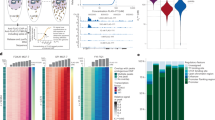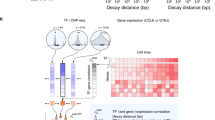Abstract
The transcription factor affinity prediction (TRAP) method calculates the affinity of transcription factors for DNA sequences on the basis of a biophysical model. This method has proven to be useful for several applications, including for determining the putative target genes of a given factor. This protocol covers two other applications: (i) determining which transcription factors have the highest affinity in a set of sequences (illustrated with chromatin immunoprecipitation–sequencing (ChIP-seq) peaks), and (ii) finding which factor is the most affected by a regulatory single-nucleotide polymorphism. The protocol describes how to use the TRAP web tools to address these questions, and it also presents a way to run TRAP on random control sequences to better estimate the significance of the results. All of the tools are fully available online and do not need any additional installation. The complete protocol takes about 45 min, but each individual tool runs in a few minutes.
This is a preview of subscription content, access via your institution
Access options
Subscribe to this journal
Receive 12 print issues and online access
$259.00 per year
only $21.58 per issue
Buy this article
- Purchase on Springer Link
- Instant access to full article PDF
Prices may be subject to local taxes which are calculated during checkout








Similar content being viewed by others
References
Wasserman, W.W. & Sandelin, A. Applied bioinformatics for the identification of regulatory elements. Nat. Rev. Genet. 5, 276–287 (2004).
Johnson, D.S., Mortazavi, A., Myers, R.M. & Wold, B. Genome-wide mapping of in vivo protein-DNA interactions. Science 316, 1497–1502 (2007).
Robertson, G. et al. Genome-wide profiles of STAT1 DNA association using chromatin immunoprecipitation and massively parallel sequencing. Nat. Methods 4, 651–657 (2007).
Hertz, G.Z. & Stormo, G.D. Identifying DNA and protein patterns with statistically significant alignments of multiple sequences. Bioinformatics 15, 563–577 (1999).
Turatsinze, J.-V., Thomas-Chollier, M., Defrance, M. & van Helden, J. Using RSAT to scan genome sequences for transcription factor binding sites and cis-regulatory modules. Nat. Protoc. 3, 1578–1588 (2008).
Rahmann, S., Müller, T. & Vingron, M. On the power of profiles for transcription factor binding site detection. Stat. Appl. Genet. Mol. Biol. 2, Article7 (2003).
Medina-Rivera, A. et al. Theoretical and empirical quality assessment of transcription factor-binding motifs. Nucleic Acids Res. 39, 808–824 (2010).
Roider, H.G., Kanhere, A., Manke, T. & Vingron, M. Predicting transcription factor affinities to DNA from a biophysical model. Bioinformatics 23, 134–141 (2007).
Manke, T., Roider, H.G. & Vingron, M. Statistical modeling of transcription factor binding affinities predicts regulatory interactions. PLoS Comput. Biol. 4, e1000039 (2008).
Warnatz, H.-J. et al. Functional analysis and identification of cis-regulatory elements of human chromosome 21 gene promoters. Nucleic Acids Res. 38, 6112–6123 (2010).
Roider, H. et al. PASTAA: identifying transcription factors associated with sets of co-regulated genes. Bioinformatics 25, 435–442 (2008).
McLeay, R.C. & Bailey, T.L. Motif Enrichment Analysis: a unified framework and an evaluation on ChIP data. BMC Bioinformatics 11, 165 (2010).
Manke, T., Heinig, M. & Vingron, M. Quantifying the effect of sequence variation on regulatory interactions. Hum. Mutat. 31, 477–483 (2010).
Aerts, S. et al. TOUCAN 2: the all-inclusive open source workbench for regulatory sequence analysis. Nucleic Acids Res. 33, W393–W396 (2005).
Ho Sui, S.J. et al. oPOSSUM: identification of over-represented transcription factor binding sites in co-expressed genes. Nucleic Acids Res. 33, 3154–3164 (2005).
Chang, L.-W., Fontaine, B.R., Stormo, G.D. & Nagarajan, R. PAP: a comprehensive workbench for mammalian transcriptional regulatory sequence analysis. Nucleic Acids Res. 35, W238–W244 (2007).
Granek, J.A. & Clarke, N.D. Explicit equilibrium modeling of transcription-factor binding and gene regulation. Genome Biol. 6, R87 (2005).
Portales-Casamar, E. et al. JASPAR 2010: the greatly expanded open-access database of transcription factor binding profiles. Nucleic Acids Res. 38, D105–D110 (2009).
Wingender, E., Dietze, P., Karas, H. & Knüppel, R. TRANSFAC: a database on transcription factors and their DNA binding sites. Nucleic Acids Res. 24, 238–241 (1996).
Defrance, M., Janky, R.s., Sand, O. & van Helden, J. Using RSAT oligo-analysis and dyad-analysis tools to discover regulatory signals in nucleic sequences. Nat. Protoc. 3, 1589–1603 (2008).
Stritt, C. et al. Paracrine control of oligodendrocyte differentiation by SRF-directed neuronal gene expression. Nat. Neurosci. 12, 418–427 (2009).
Schaefer, A.S. et al. A genome-wide association study identifies GLT6D1 as a susceptibility locus for periodontitis. Hum. Mol. Genet. 19, 553–562 (2010).
Reddy, T.E. et al. Genomic determination of the glucocorticoid response reveals unexpected mechanisms of gene regulation. Genome Res. 19, 2163–2171 (2009).
De Bosscher, K. Selective glucocorticoid receptor modulators. J. Steroid Biochem. Mol. Biol. 120, 96–104 (2010).
Fujita, P.A. et al. The UCSC genome browser database: update 2011. Nucleic Acids Res. 39, D876–D882 (2011).
Hufton, A. et al. Deeply conserved chordate non-coding sequences preserve genome synteny but do not drive gene duplicate retention. Genome Res. 19, 2036–2051 (2009).
van Helden, J. Regulatory sequence analysis tools. Nucleic Acids Res. 31, 3593–3596 (2003).
Thomas-Chollier, M. et al. RSAT: regulatory sequence analysis tools. Nucleic Acids Res. 39, W86–W91 (2008).
Giardine, B. et al. Galaxy: a platform for interactive large-scale genome analysis. Genome Res. 15, 1451–1455 (2005).
Goecks, J., Nekrutenko, A., Taylor, J. & Team, T.G. Galaxy: a comprehensive approach for supporting accessible, reproducible, and transparent computational research in the life sciences. Genome Biol. 11, R86 (2010).
Christoffels, V. et al. Glucocorticoid receptor, C/EBP, HNF3, and protein kinase A coordinately activate the glucocorticoid response unit of the carbamoylphosphate synthetase I gene. Mol. Cell Biol. 18, 6305–6315 (1998).
De Gobbi, M. et al. A regulatory SNP causes a human genetic disease by creating a new transcriptional promoter. Science 312, 1215–1217 (2006).
Acknowledgements
This work was supported by the Alexander von Humboldt foundation. We thank A. Mysickova for her insightful comments on this protocol, and S. Haas for helpful discussions.
Author information
Authors and Affiliations
Contributions
H.G.R., T.M. and M.V. developed the original TRAP approach and the P value calculation. M.H., T.M. and M.V. developed the sTRAP approach. A.H. implemented the combination of P values approach and the first version of the web tools. M.T.-C. integrated the different approaches, added new matrix and background models, and supervised the remodeling of the website by N.E.M. S.O. helped in the implementation of the website. M.T.-C. wrote the manuscript, and A.H., S.O., H.G.R. and T.M. edited the manuscript.
Corresponding author
Ethics declarations
Competing interests
The authors declare no competing financial interests.
Rights and permissions
About this article
Cite this article
Thomas-Chollier, M., Hufton, A., Heinig, M. et al. Transcription factor binding predictions using TRAP for the analysis of ChIP-seq data and regulatory SNPs. Nat Protoc 6, 1860–1869 (2011). https://doi.org/10.1038/nprot.2011.409
Published:
Issue Date:
DOI: https://doi.org/10.1038/nprot.2011.409
This article is cited by
-
Integration of single-cell transcriptomics and epigenetic analysis reveals enhancer-controlled TIMP1 as a regulator of ferroptosis in colorectal cancer
Genes & Genomics (2024)
-
A DNA methylation signature in the stress driver gene Fkbp5 indicates a neuropathic component in chronic pain
Clinical Epigenetics (2023)
-
NRF2 has a splicing regulatory function involving the survival of motor neuron (SMN) in non-small cell lung cancer
Oncogene (2023)
-
Genetic susceptibility to diabetic kidney disease is linked to promoter variants of XOR
Nature Metabolism (2023)
-
Functional characterization of the Komagataella phaffii 1033 gene promoter and transcriptional terminator
World Journal of Microbiology and Biotechnology (2023)
Comments
By submitting a comment you agree to abide by our Terms and Community Guidelines. If you find something abusive or that does not comply with our terms or guidelines please flag it as inappropriate.



